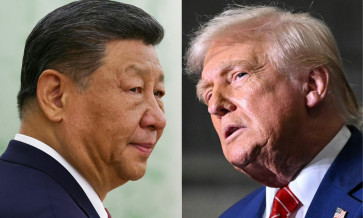Popular Reads
Top Results
Can't find what you're looking for?
View all search resultsPopular Reads
Top Results
Can't find what you're looking for?
View all search resultsPast glory shines at Indonesian Islamic Art Museum
Selfie time: Visitors take a picture in front of a replica of Knight of Moslem in a coat of armor
Change text size
Gift Premium Articles
to Anyone
Selfie time: Visitors take a picture in front of a replica of Knight of Moslem in a coat of armor.
Lamongan, a coastal town in the north of East Java, offers historical information on the world of Islam through the Indonesian Islamic Art Museum.
The museum, located in Lamongan’s Paciran district, depicts the grandeur of Islam throughout the globe through various features displayed across three main zones.
The first zone is the museum’s audiovisual zone, where visitors can watch a 15-minute film about the history of Islamic civilizations, from the Arabian Peninsula, the arrival of Prophet Muhammad and the caliphate period to the worldwide propagation of Islam.
The museum’s second zone features historical objects from the past glory of Islam from ancient kingdoms and empires located in Turkey, Mughal (now Pakistan and India), China and Indonesia.
Finally, the third zone displays a diorama of three-dimensional miniatures, ranging from the Banten Grand Mosque to the ship of Admiral Cheng-Ho. This area also serves as a photo spot for visitors, who are shown by a guide around the museum for a fee of Rp 15,000 (US$1.04) on weekdays and Rp 20,000 on weekends.
Islamic Museum Foundation manager Reno Halsamer said he set up the museum on Dec. 28, 2016, in view of Indonesia’s dire need to have a gallery describing the early history of Islam.
“Islamic art museums of this kind have also been established in Turkey, Australia, the United States, Canada and Singapore,” Reno said, adding that he hoped to inspire greater appreciation of Islamic art, which holds its own against the artistic artifacts of other cultures.
“In my view, Islamic art in the Middle East is even more unique and attractive, because of its combination of various elements, including from Persia, China and Europe,” he said.
Golden letters: Al Quran written in gold ink believed to date back to the 13th centuryCooperating with a team from the Maulana Malik Ibrahim State Islamic University in Malang, East Java, Reno arranged the narration for the hundreds of artifacts he has gathered in the last 25 years.
He specifically highlighted the development of Islamic art in Turkey, the Mughal Empire and China, because they had strong correlations with the development of Islam in Indonesia.
Turkey’s Ottoman Empire, for example, was one of the largest Islamic kingdoms that reigned for more than 600 years and had contact with Indonesia during this period.
“Turkey once maintained diplomatic ties with Aceh, even with Islamic kingdoms of Mataram,” Reno said.
Among the Ottoman artifacts featured in the museum are a zirah (coat of armor) made from 25 kilograms of iron from the mid-16th century and a Quran written in gold ink, believed to have originated in the 13th century.
Other than the Ottoman Empire, the Mughal Empire also played a vital role in the entry of Islam to Indonesia. Islam spread to India in about the seventh century, including the Gujarat region in India.
“Muslim traders from Gujarat entered and propagated Islam in Indonesia,” Reno said.
An important landmark in the dissemination of Islamic art was the arrival of admiral Cheng Ho with Muslim traders from the eastern coast of China to visit Indonesia’s coastal towns in the early 15th century. Among the artifacts left are a number of ceramics adorned with calligraphy.
Visitors can use the Augmented Reality (AR) application to enjoy three-dimensional images of some pictures and listen to accompanying narrations at the museum.
Immersive: Visitors can use the Augmented Reality (AR) application to enjoy three dimensional images of several pictures or narrations at the museum.There are also collections of various objects from Islamic kingdoms in Indonesia, like those of Samudra Pasai as the first Islamic kingdom in Indonesia, as well as books from Islamic Mataram kingdoms and on the history of Wali Songo (Indonesia’s Nine Islamic Saints).
Reno described the information on the Wali Songo era as the most important part for visitors.
“It narrates how traditional arts such as books, wayang [shadow puppet play] and gamelan were used as a medium for the peaceful entry of Islam to Java,” he said.
The Wali Songo is also the reason why Reno opened the museum in Lamongan. This region was where Islamic teachings were intensively propagated by the Wali Songo. The spread of Islam in East Java was inseparable from the role of five of the nine saints.
The five were Sunan Ampel in Surabaya, Sunan Gresik and Sunan Giri in Gresik, Sunan Drajat in Lamongan and Sunan Bonang in Tuban, each of whom was entombed in their respective cities.
“I also have a spiritual bond with Lamongan because one of my ancestors used to serve as adipati [regional head] in Lamongan,” said Reno, who with his wife Elly T. Halsamer also manages the History of Java Museum in Yogyakarta and d’Topeng Museum in Batu, East Java.
Reno highly admires the saints for their struggle to spread Islamic teachings among Hindu-Buddhist communities in a peaceful way.
“I hope that with this understanding, visitors can learn from and appreciate the museum’s collections of artifacts,” he said.
Ancient tools: Visitors look at a chair used by a boy after being circumcised in Madura, East Java.— Photos by JP/Nedi Putra AW













